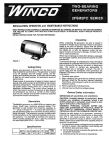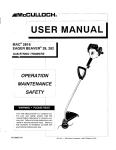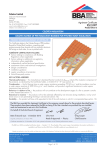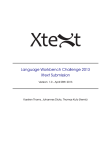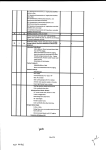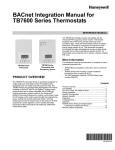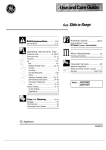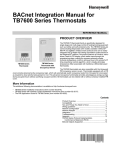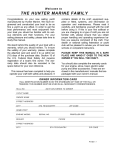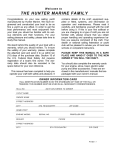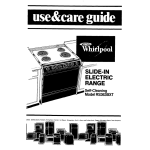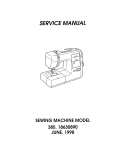Download Operators Manual
Transcript
A Div~sionof BRUSHLESS TWO-BEARING Technology Znc GENERATORS INSTALLATION, OPERATION,and MAINTENANCE INSTRUCTIONS OWNERS MANUAL - A Division of -Dy& - - Techno/oogyfnc Read and understand all instructions in the manual before starting and operating the generator set. USING THIS MANUAL Congratulations on your choice of a Wnco generator set. You have selected a high-quality, precision-engineered generator set designed and tested to give you years of satisfactory portable service. To get the best performance from your new engine generator set, it is important that you carefully read and follow the operating instructions in this manual. Should you experience a problem please follow the "Things To Check" near the end of this manual. The warranty listed in this manual describes what you can expect from WlNCO should you need service assistance in the future. TABLE OF CONTENTS INTRODUCTION 12 MONTH WARRANTY GUIDETOPRODUCTSAFETY BASIC INFORMATION Specification Table Unit Capabilities Unpacking the unit lNSTALLATIONlOPERATlON Assembly Plan The Installation Connecting The Load Common Problems PROPER USE AND INSTALLATION You must be sure your new generator set is: * Properly serviced before starting * Wired by a qualified electrician * Operated only for its designed purposes * Used only by operators who understand its operation Properly maintained COPY YOUR MODEL AND SERIAL NUMBER HERE No other WlNCO generator has the same serial number as yours. It is importantthat you recordthe number and other vital information here. If you should ever need to contact us on this unit it will help us to respond to your needs faster. MODEL SERIAL NUMBER i i 1 PURCHASE DATE DEALER WINCO, Inc. 12 Month Limited Warranty WINCO, Incorporated warrants to the original purchaser for 12 months that goods manufactured or supplied by it will be free from defects in workmanship and material, provided such goods are installed, operated and maintained in accordance with Winco written instructions. WINCO's sole liability, and Purchaser's sole remedy fora failure under this warranty, shall be limited to the repairof the product. At WINCO's option, material found to be defective in material or workmanship under normal use andservice will be repaired or replaced. For warranty service, return the product within 12 months from the date of purchase, transportation charges prepaid, to your nearest WlNCO Authorized Service Center or to WINCO, Inc. at Le Center Minnesota. THERE IS NO OTHER EXPRESS WARRANTY. To the extent permitted by law, any and all warranties, including those of merchantability and fitness for a particular purpose, are limited to 12 months from date of purchase. In no event is WINCO liable for incidental or consequential damages. Note: Somestates do notallowlimitation on the duration ofimplied warrantyandsomestates do notallowthe exclusion or limitation of incidental or consequential damages, so the above limitations may not apply in every instance. This warranty gives you specific legal rights which may vary from state to state. WlNCOreserves the right to change or improve its products without incurring any obligations to make such changes or improvement on products purchased previously. EXCLUSIONS: WlNCO does not warrant engines, batteries, or other component parts that are warranted by their respective manufacturers. WlNCO does not warrant modifications or alterations which were not made by WINCO, Inc. GUIDE TO PRODUCT SAFETY L This engine generator set has been designed and manufactured to allow safe, reliable performance. Poor maintenance, improper or careless use can result in potential deadly hazards; from electricalshock, exhaust gas asphyxiation, or fire. Please read all safety instructions carefully before installationor use. Keep these instructions handy for future reference. Take special note and follow all warnings on the unit labels and in the manuals. ANSI SAFETY DEFINITIONS DANGER: DANGER indicates an imminently hazardous situation which, if not avoided, will result in death w serious injury. This signal word i s to be limited to the most extreme situations. WARNING: WARNING indicates a potentially hazardoussituation which, ifnotavoided, could result in death o r serious injury. CAUTION: CAUTIONindicatesapotentiallyhazardous situation which, if n o t avoided, may result inminor o r moderate injury. I t may also b e used to alert against unsafe practices. NOTE: CAUTIONisalso usedon the unitlabels and inthismanualto indicate a situation that could result in serious damage o r destruction o f the equipmentandpossible personalinjury. 2. FIREHAZARD-Gasolineand otherfuelsalways present a hazard of possible explosion andlor fire. a. Do not refuel when the engine is running or hot. Allow the engine to cool at least two minutes before refueling. b. Keep fuel containers out of reach of children. c. Do not smoke or use open flame near the generator set or fuel tank. d. Keep a fire extinguisher nearby and know its proper use. Fire extinguishers rated ABC by NFPA are appropriate. e. Store fuel only in an approved container, and only in a well-ventilated area. 3. DEADLY EXHAUSTGAS -Exhaustfumesfrom any gasoline enginecontain carbon monoxide, an invisible, odorless and deadly gas that must be mixed with fresh air. a. Operate only in well ventilated areas. b. Never operate indoors. c. Never operate the unit in such a way as to allow exhaust gases to seep back into closed rooms (i.e. through windows, walls or floors). - 4. NOISE HAZARD Excessive noise is not only tiring, but continual exposure can lead t o loss of hearing. a.Use hearing protection equipment when working around this equipment for long periods of time. b. Keep your neighbors in mind when permanently installing this equipment. 5. CLEANLINESS- Keep the generator and surrounding area clean. a. Remove all grease, ice, snow or materials that create slippery conditions around the unit. b. Remove any rags or other material that could create potential fire hazards. c. Carefully wipe up any gas or oil spills before starting the unit. d. Never allow leaves or other flammable material to build up around the engine exhaust area. 6. SERVICING EQUIPMENT-All service, including the installation or replacement of service parts, should be performed only by a qualified technician. a. Use only factory approved repair parts. b. Do not work on this equipment when fatigued. c. All belts, pullies andlor drive shafts must have protective guards andlor covers permanently installed by the assembler. d. Never remove the protective guards, cover, or receptacle panels while the engine is running. e. Use extreme caution when working on electrical components. High output voltages from this equipment can cause serious injury or death. f. Always avoid hot mufflers, exhaust manifolds, and engine parts. They all can cause severe burns instantly. 1. ELECTRICSHOCK- The output voltage present in this equipmentcan causeafatalelectric shock. Thisequipment must be operated by a responsible person. L a. Do not allow anyone to operate the generator without proper instruction. b. Guard against electric shock. c. Avoid contact with live terminals or receptacles. d. Use extreme care if operating this unit in rain or snow. e. Use only three-prong grounded receptacles and extension cords. f. Be sure the unit is properly grounded to an external ground rod driven into the earth. Page 1 TB SERIES BASIC INFORMATION TESTING POLICY: CONVENTIONAL D U A L VOLTAGE 1 2 0 / 2 4 0 VOLT SCHEMATIC Before any generator is shipped from the factory, it is fully checked for performance. The generator is loaded to its full capacity, and the voltage, current, and frequency are carefully checked. Rated output of generators is based on factory tests of typical units, and is subject to, and limited by the ambient operating temperature. The generator will not provide full power output unless driven by a prime mover of adequate horsepower. The prime mover (engine or other input power source) horsepower is also affected by temperature as well as a number of other factors such as: fuel, altitude, and all other conditions specified by the prime mover manufacturer. Neutral E -- - A A 120 Volts G r o ~ n d ~r\k ' 2 $ o c l e s INTRODUCTION AND DESCRIPTION TYPICAL 4000 WATT GENERATOR The generator is a 3600 rpm two bearing, belt driven, brushless, revolving field design. The generator is self excited and inherently regulated to +(plus I- or minus) 7% - no load to full rated load. It can be operated under any load within its rating without being damaged. The frequency regulation is determined by the sensitivity of the customer supplied prime movers' governor. It is desirable to maintain this speed to within 3 cycles variation (61.5 Hz 58.5 Hz) no load to full rated load (3690 rpm - 3510 rprn). The following currents (measured in amps) are produced at 120 & 240 volts for typical wattage shown. AMPS AT 120 VOLT 240 VOLT RECEPTACLE ID MODEL A C B TB1500C 12.5 NIA NIA TB2400C 20 NIA NIA TB4000C 16.7 16.7 16.7 TB4000* 16.7 16.7 16.7 TB6000C 25 25 25 TB6000* 25 25 25 TB7200** 30 30 30 'Customer connections are made on the back side of the circuit breaker - Generator Specifications MODEL WATS VOLTS AMPS HZ PH RPM ** This unit has a junction box rather than receptacles. Ref. "amisthe G I lead, Ref. "c" is the G3 lead and Ref. "b" is G I to G3 rating UNIT CAPABILITIES 1. Generator Coni-lections- The diagram below represents a typical ordinary 4000 watt generator. Only 2000 watts at 120 volts (16.7 Amps) can be taken from the generator at receptacle A and up to 2000 watts at 120 volts from receptacle C. On an ordinary generator, CAUTION MUST BE EXERCISEDTO PREVENTOVERLOADINGEITHER OF THE 120 VOLT CIRCUITS (A OR C). TB SERIES 2. Starting Electric Motors - Electric motors require much more current (amps) to start them than to run them. Some motors, particularly low cost split-phase motors, are very hard to start and require 5 to 7 times as much current to start them as to run them. Capacitor motors are easier to start and usually require 2 to 4 times as much current to start them as to run them. Repulsion Induction motors are the easiest to start and usually require 1-112 to 2-112 times as much to start them as to run them. Page 2 Most fractional horsepower motors take about the same amount of current to run them whether they are of Repulsion-Induction (RI), Capacitor (Cap), or Split-Phase (SP) type. The chart below shows the approximate current required to start and run various types of sizes of 120 volt 60 cycle electric motors under average load conditions. 60706-098 - BASIC INFORMATION - HP 116 114 113 112 1 RUNNING AMPS 3.2 4.5 5.2 7.2 13.0 SP 1 6 T 0 22 22TO32 26TO35 NOTMADE NOTMADE STARING AMPS CAP RI 6 TO13 S T 0 8 9T018 7T012 1 0 T 0 2 18T017 14TO2911TO18 26 TO 52 20 TO 33 The figures given above are for average load such as a blower or fan. If the electric motor is connected to a hard starting load such as an air compressor, it will require more starting current. If it is connected to a light load, or no load such as a power saw, it will require less starting current. The exact requirement will also vary with the brand or design of the motor. For 240 volt motors, the "running" current is half as much as shown for the 120 volt motors of the same size. Some dual voltage 1201240 volt motors are difficult to start on 240 volts when driven by enginelgenerators and can be started more easily when connected to operate on 120 volts. This is particularly true of "capacitor start-induction run" motors. Sometimes a 240 volt motor which cannot be started on the 240 volt circuitof a 1201240voltgenerator can be started on a 120 volt circuit and then auicklv switched to the 240 volt circuit after it is started. c his c a i be done in applications where the motor is manually controlled and is started under "no load" conditions. -, Generator Model Trying to start a larger motor or higher code (ie. J or K) motor may result in damage to boththe generatorand the electric motor especially 120 volt motors. UNPACKING INSTRUCTIONS ** NOTICE ** When unpacking the generator, be sure to inspect it carefully for freight loss or damage. If loss or damage is noted at the time of delivery, require that the person making the delivery make a note of the loss or damage on the freight bill, or affix his signature under the consigner's memo of the loss or damage. Contact the carrier for claim procedures. When loss or damage is noted after delivery, segregate the damaged material, and contact the carrier for claim procedures. A self-excited generator responds differently to severe overloading than the power line. To illustrate, suppose that a 240 volt 10 H.P. "capacitor start-Induction Run" motor is connected to the generator. The engine would not be able to supply enough power to bring the electric motor up to operating speed. The generator would respond with high initial starting current, but the engine would be very severely overloaded. The speed would probably drop sharply and possibly stall the engine. If allowed to operate at very low speeds, the electric motor startwinding would burn out in a shorttime. The generator winding might also be damaged. "CONCEALED DAMAGE" is understood to mean damage to the contents of a package which is not in evidence at the time of delivery by the carrier, but which is discovered later. The carrier or carriers are responsible for merchandise lost or damaged in transit. The title to goods rests with the consignee when generators are shipped fob factory, and only the consignee can legally file claims. 1. Carefully open carton. 2. After inspecting the generator for external physical damage, check for the owner's manual (operating instructions, wiring diagram, parts list) inside the carton. On the other hand, suppose a smaller electric motor that requires just a little more output than the generator can produce is connected to it. It will try to run but will not reach a high enough speed for the internal centrifugal switch to disconnect the starting winding. The generator output, instead of being 120 volts, may drop to 70 or 80 volts. RUNNING THE GENERATOR SET UNDER EITHER OF THESE CONDITIONS COULD RESULT IN DAMAGE TO THE GENERATORSTATORASWELLAS THE MOTOR WINDING. L Because the heavy surge of current required for starting motors is required for only an instant, the generator will not be damaged if it can bring the motor up to speed in a few seconds of time. If difficulty is experienced in starting motors, turn all other electrical loads off and if possible reduce the load on the electric motor. 3. Motor Starting Ca~acitv- listed below vou will find the motor starting ~>~al;ilit~ bf your engine ienerator set. 60706-098 Motor Size (code "G"capacitor start) 2. Remove generator hold down bolts. 4. Unit can now be lifted from shipping base. **** CAUTION **** Before proceeding with the installation, be sure that you have completely read and understand the assembly and installation instructions. ASSEMBLY 1. An engine with adequate horsepower and a close regulating (fixed speed) governor is required for satisfactory operation of any alternating current generator. Page 3 TB SERIES INSTALLATION These units require approximately two (2) horsepower for every 1000 watts of generator output. Theoretically you should be able to produce 1000 watts with 1.4 Horsepower, but this is only possible with 100% efficiencies in both the engine and the generator. Between engine and generator efficiencies of only 80% to 90% and the losses through the drive system the two horsepower requirement is more realistic. together with the natural "voltage drop" within the generator itself due to load current and heating of the windings, results in a slightly lower voltage than when the generator is running idle. The normal, slight variations in speed also directly affect the frequency of the output current. This frequency variation has no appreciable effect in the operation of most loads (such as motors, lights and most small appliances). However, timing devices and clocks will not keep perfect time unless the engine can keep the generator running at exactly 3600 rpm at all times. Since this is not usually possible, minor time errors in clocks occur. For example, this 1,500 watt generator output will require a 3 or 4 h.p. Engine for full output, good speed I voltage regulation, and satisfactory load performance. 2. When determining the prime mover Igenerator pulley ratio to drive the generator at the correct operating speed, bear in mind that the power rating of most prime movers (usually an engine) varies with the speed-that is, it produces more power at higher speeds, less when slowed. The prime mover must be run fast enough to reach the desired horsepower for good generator set operation. The speed of the engine is usually adjusted so that the generator produces proper voltage. If the adjustment is made "cold", set the voltage a little higher than normal since it will drop a few volts as the generator warms up. **" CAUTION **** When operating continuously at full load the generator shell becomes very warm. It will be uncomfortable to the touch-this is normal for any high performance inherently regulated generator. The drive belt system must be of adequate size and must be tight enough to power the generator without slippage. Be careful not to overtighten to the extent that it puts excessive strain on the bearings--doing so can cause bearing failure and other possible damage to the generator. Output voltage should be checked periodically to insure proper operation of the generating plant and appliances. Alignment of the generator to the prime mover is important. Misalignment of the pullies will cause excessive belt and pulley wear and unnecessary stress on the prime mover. **** CAUTION "** Although individual units and models may vary slightly, the normal voltage and frequency of typical 60 cycle generators described in this book are approximately as follows when powered by a typical prime mover (engine) run first with no load applied, then at half the generator capacity and finally when loaded to its full capacity as rated on the nameplate: Required generator speed must be maintained at 3600 +I- 90 rpm under all load conditions. 4.All engines have a tendency to slow down when a load is applied. The governor on the engine is designed to hold the engine speed nearly constant. When the electrical load connected to the generator is increased, the engine is more heavily loaded and as a result the speed drops slightly. This slight decrease in speed TB SERIES PLAN THE INSTALLATION Plans for installation should be prepared with proper attention to mechanical and electrical engineering detail to assure a satisfactory system installation. The information in this manual is offered as a guide to finalizing your installation plans. The installation sequence is summarized below: VOLTAGE 129VOLTS 120VOLTS 115VOLTS **** CAUTION **** - Low voltage may damage any motors or appliances connected to it. Running the generator at excessively high speeds results in too high voltage which will also damage electrical devices connected to it. Excessively high speed may also cause damage to the generator stator windings. 3. The following table shows the effect of various operating speeds and electrical loads on a typical generator when matched and mounted to an adequate prime mover GENERATOR LOAD SPEED FREQUENCY NONE 3690 RPM 61 112 HZ HALF 3600RPM 60HZ FULL 3510 RPM 58 112 HZ -- Generally these two bearing generators are used on portable equipment. For best service consider the following : 1.All electrical equipment should be protected from excessive moisture. Failure to do so will result in deterioration of the insulation and will result in short circuits and grounds. 2. The generator should be installed in a sheltered area. If the unit must be left in the open, it should always be protected with a weather cover such as a tarp or large piece of canvas after each use to keep out water and dust. P'age 4 60706-098 - BASIC OPERATION - "* CAUTION **** pump and other items to be powered directly into the generator receptacles. Before plugging in all the tools and cord sets, recheck the rating of the generator set. Be sure it can handle the intended load and is compatible with the voltage, phase, and current ratings. Always allow the generator and prime mover to cool before covering with a flammable weather covering. **** CAUTION *"* The generator must be mounted with the engine to a common rigid base to prevent stress on the engine and generator shafts and bearings due to vibration displacement. For permanent installations, the engine-generator is usually mounted on a subframe which can be shock mounted with special neoprene pads on the main frame. f. 'Hard Wiring' this unit directly into a temporary construction site electrical system is NOT A SIMPLE DO-ITYOURSELF JOB. For your safety all wiring must be done by a qualified electrician and conform to the National Electric Code and comply with all state and local codes and regulations. Check with local authorities before proceeding. CONNECTING THE LOADS ****WARNING"" 1. Applying The Load - A shortwarm-up time will permitthe engine to work more efficiently when the load is applied and will reduce the wear and extend its life. a. Rece~tacleshave been Drovided on the control Dane1 tocohect the loads on the models, TBI ~ O O C T,B ~ ~ O O C , TB4000C, TB6000C. On the models TB2400, TB4000, TB6000 the connections are made on the back side of the circuit breakers. The TB7200 has a junction box mounted on the top of the generator. The loads should be applied gradually. If a large motor is being started or multiple motors are being started, they should be started individually and the largest should be started first. L **" CAUTION **** PERSONAL DANGER A fully isolated, double pole double throw manual transfer switch must be installed any time a generator is being connected to an existing distribution system. **"CAUTION"* COMMON PROBLEMS EQUIPMENTOVERLOAD-Keepthe generator loadwithin the generator and receptacle nameplate rating. Overloading may cause damage to the generator andlor the loads b. Most electric tools and appliances will have the voltage and amperage requirements on their individual nameplates. When in doubt consult the manufacturer or a local electrician. The nameplate amperage rating for electric motors can be misleading. See "Starting Electric Motors" in Specification Section. - EQUIPMENT DAMAGE Failure to properly limit and balance the load applied to the generator will cause the generator to produce low voltage and may damage the engine generator set. It may also cause severe damage to the loads connected to the generator at that time. Improper loading of the generator set constitutes abuse and will not be covered by warranty. Sometimes problems can be easily solved by checking a few basic things. Check below before you call or take your unit to a service center. It could save you time and money. Voltage too low c. These engine generator sets are inherently self regulating based on engine speed. The engine governor will automatically adjust itself to the load. No harm to the generator will result if it is operated with no load connected. *Engine speed is too low. *Generator overloaded. *Defective stator. *Defective rotor (field). Circuit Breaker Trips 'Defective load. *Defective receptacle. Voltagetoo high *Engine speed is too high. Generatoroverheating *Overloaded. *Insufficient ventilation. d. Proper. utilization amperage is necessary to prevent damage to either the receptacleslbreakers or the generator. The generator is a limited source of electrical power, therefore pay special attention to the receptacle and generator ratings. The nameplate rating can be obtained through a combination of receptacles or a single receptacle as long as the receptacle amperage rating is not exceeded. Both the 120 and 240volt output can be utilized at the same time. See Specification Section for proper load separation. Nooutputvoltage *Short in load (disconnect). *Broken or loose wire. *Defective receptacle. *Defective capacitor. *Defective diode. *No residual magnetism in generator. *Defective stator. "Defective rotor (field). e. Plug your tools such as drills, saws, blowers, sump 60706-098 Page 5 TB SERIES WIRING DIAGRAMS EXCl TATlON WINDING (STATOR) CIRCUIT BREAKERS A.C. OUTPUT WINDING (STATOR) UNMARKED LEADS 1 EXCITATION FIELD COILS (ROTOR) RECTIFIERS EXClTATlON WINDING 7*-- CIRCUIT BREAKER RECEPTACLES CAPACITOR UNMARKED LEADS RECTIFIERS COILS (ROTOR) CIRCUIT BREAKER w d EXCITATION WINDING ,rn f A.C. OUTPUT WlNDlNG 120 VOLTS UNMARKED LEADS EXCITATION RECTIFIERS COILS (ROTOR) A Division of DTLD p Techno/ogyfnc 225 South CordovaAvenue Le Center, Minnesota 56057 kr_, vOrl VOLTS 120 BREAKER 1








